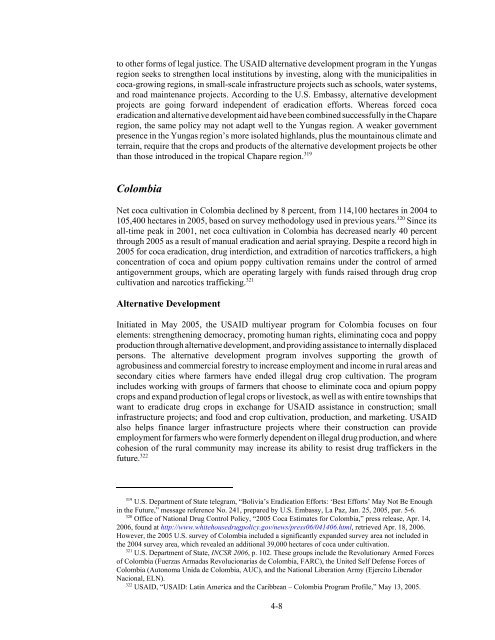The Impact of the Andean Trade Preference Act Twelfth ... - USITC
The Impact of the Andean Trade Preference Act Twelfth ... - USITC
The Impact of the Andean Trade Preference Act Twelfth ... - USITC
- No tags were found...
You also want an ePaper? Increase the reach of your titles
YUMPU automatically turns print PDFs into web optimized ePapers that Google loves.
to o<strong>the</strong>r forms <strong>of</strong> legal justice. <strong>The</strong> USAID alternative development program in <strong>the</strong> Yungasregion seeks to streng<strong>the</strong>n local institutions by investing, along with <strong>the</strong> municipalities incoca-growing regions, in small-scale infrastructure projects such as schools, water systems,and road maintenance projects. According to <strong>the</strong> U.S. Embassy, alternative developmentprojects are going forward independent <strong>of</strong> eradication efforts. Whereas forced cocaeradication and alternative development aid have been combined successfully in <strong>the</strong> Chapareregion, <strong>the</strong> same policy may not adapt well to <strong>the</strong> Yungas region. A weaker governmentpresence in <strong>the</strong> Yungas region’s more isolated highlands, plus <strong>the</strong> mountainous climate andterrain, require that <strong>the</strong> crops and products <strong>of</strong> <strong>the</strong> alternative development projects be o<strong>the</strong>rthan those introduced in <strong>the</strong> tropical Chapare region. 319ColombiaNet coca cultivation in Colombia declined by 8 percent, from 114,100 hectares in 2004 to105,400 hectares in 2005, based on survey methodology used in previous years. 320 Since itsall-time peak in 2001, net coca cultivation in Colombia has decreased nearly 40 percentthrough 2005 as a result <strong>of</strong> manual eradication and aerial spraying. Despite a record high in2005 for coca eradication, drug interdiction, and extradition <strong>of</strong> narcotics traffickers, a highconcentration <strong>of</strong> coca and opium poppy cultivation remains under <strong>the</strong> control <strong>of</strong> armedantigovernment groups, which are operating largely with funds raised through drug cropcultivation and narcotics trafficking. 321Alternative DevelopmentInitiated in May 2005, <strong>the</strong> USAID multiyear program for Colombia focuses on fourelements: streng<strong>the</strong>ning democracy, promoting human rights, eliminating coca and poppyproduction through alternative development, and providing assistance to internally displacedpersons. <strong>The</strong> alternative development program involves supporting <strong>the</strong> growth <strong>of</strong>agrobusiness and commercial forestry to increase employment and income in rural areas andsecondary cities where farmers have ended illegal drug crop cultivation. <strong>The</strong> programincludes working with groups <strong>of</strong> farmers that choose to eliminate coca and opium poppycrops and expand production <strong>of</strong> legal crops or livestock, as well as with entire townships thatwant to eradicate drug crops in exchange for USAID assistance in construction; smallinfrastructure projects; and food and crop cultivation, production, and marketing. USAIDalso helps finance larger infrastructure projects where <strong>the</strong>ir construction can provideemployment for farmers who were formerly dependent on illegal drug production, and wherecohesion <strong>of</strong> <strong>the</strong> rural community may increase its ability to resist drug traffickers in <strong>the</strong>future. 322319U.S. Department <strong>of</strong> State telegram, “Bolivia’s Eradication Efforts: ‘Best Efforts’ May Not Be Enoughin <strong>the</strong> Future,” message reference No. 241, prepared by U.S. Embassy, La Paz, Jan. 25, 2005, par. 5-6.320 Office <strong>of</strong> National Drug Control Policy, “2005 Coca Estimates for Colombia,” press release, Apr. 14,2006, found at http://www.whitehousedrugpolicy.gov/news/press06/041406.html, retrieved Apr. 18, 2006.However, <strong>the</strong> 2005 U.S. survey <strong>of</strong> Colombia included a significantly expanded survey area not included in<strong>the</strong> 2004 survey area, which revealed an additional 39,000 hectares <strong>of</strong> coca under cultivation.321 U.S. Department <strong>of</strong> State, INCSR 2006, p. 102. <strong>The</strong>se groups include <strong>the</strong> Revolutionary Armed Forces<strong>of</strong> Colombia (Fuerzas Armadas Revolucionarias de Colombia, FARC), <strong>the</strong> United Self Defense Forces <strong>of</strong>Colombia (Autonoma Unida de Colombia, AUC), and <strong>the</strong> National Liberation Army (Ejercito LiberadorNacional, ELN).322 USAID, “USAID: Latin America and <strong>the</strong> Caribbean – Colombia Program Pr<strong>of</strong>ile,” May 13, 2005.4-8
















